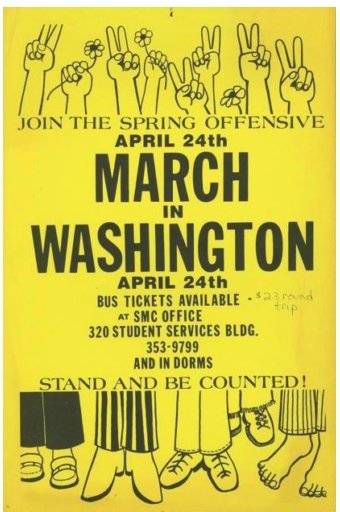 Social activist, pastor and MSU graduate Jim Wallis, in a visit to East Lansing in 2006, stressed how his involvement in the university’s antiwar protests of the late 1960s changed his life.
Social activist, pastor and MSU graduate Jim Wallis, in a visit to East Lansing in 2006, stressed how his involvement in the university’s antiwar protests of the late 1960s changed his life.“MSU forged who I am,” he said.
It was a turbulent era at the university, and demonstrations against the Vietnam War were a regular occurrence. Most of the campus demonstrations were heralded by simple, often hand-drawn posters that were tacked up on bulletin boards across campus, inviting students to rallies, demonstrations and marches.
The late Val Berryman, a former MSU Museum curator, grabbed many of them off bulletin boards, squirrelling them away for posterity. Mary Worrall, the museum’s cultural heritage curator, is using Berryman’s cache for “Student Voices,” an exhibit on student activism that opens next month.
In response to the recent reinvigoration of activism on campus — led by the Black Lives Matter movement — Worrall decided to look into the museum’s collection of ephemera to “make connections to the past.”
While the 1960s were the pinnacle of student demonstrations, student activism “never stopped,” she added. The exhibit includes a display of dozens of posters and fliers promoting causes and events as far flung as the anti-apartheid movement, the Gallo wine strike of the 1970s, the gay brothers and sisters gathering of 1972, a free Bobby Seale rally and a “Stop the Shah” event to protest the controversial MSU-Iran Film Project. Worrall hopes that professors will bring their classes to examine the posters and handbills and use them to spark class discussions and writing exercises.
“I hope to help create dialogue for current events,” she said.
“Physical items can be a catalyst for discussion.”
The exhibit will also take a look at how modern students coordinate demonstrations and raise awareness of issues by using social media.
“What used to be a flier is now a tweet,” she said. “Although communication is more virtual, there is still non-virtual ephemera like posters.”
The exhibit will show how even the evolution of handbills has been shaped by technology. Over time, posters go from hand-lettered, photocopied missives to elaborate computer-designed layouts. In the aftermath of the events in Ferguson, museums across the country began reevaluating what they should collect, including everything from Facebook posts to cell phone videos.
The exhibit also includes photographs of “the Rock,” MSU’s famed boulder that for decades has been painted with messages for or against causes of all kinds. One goal of Worrell’s goals is to connect to students to the vast array of on-campus demonstrations related to social justice.
One of the more interesting parts of the exhibit, Worrall said, is the collection related to a campus strike following the 1970 Kent State shootings. In protest to the killings and the ramping up of the Vietnam War, many students quit going to classes. One rare poster from the era features an upraised fist drawn in graffiti-style art with the words “on strike” emblazoned across it in red.
Another piece, from the faculty graduate assistant strike committee, argues that “students who are striking are doing so for the highest moral reasons and should be supported.” Among its recommendations is that “a student would be given a grade for the course based on his work up to the time he joined the strike.”
In addition to the “Student Voices” exhibit — which opens in coordination with the Jan. 18 Martin Luther King Jr. Day programs on campus — the museum is also mounting “Up Cloche,” an exhibit that highlights fashion, feminism and modernity with a focus on the 1920s and 1930s. “Up Cloche” opens Jan. 4. A related Feb. 25 fundraiser at MSU’s Kellogg Center features cocktails and canapés and a prohibition-era speakeasy theme.
Worrall said there is a dearth of material relating to women’s issues in the museum’s collection. She also noted that the social movements of the ‘80s and ‘90s aren’t well represented either. The museum is interested in donations of documents and other ephemera in those areas. Worrall hopes that “Student Voices” will show that even “throw-away” items like event posters can become important historical documents.
“The exhibit will help the museum to think about what we are collecting relating to social justice,” she said.
“Student Voices: MSU Student Protest”
Jan. 18-May 1 FREE ($5 suggested donation) MSU Museum 409 W. Circle Drive, East Lansing (517) 355-2370, museum. msu.edu
Support City Pulse - Donate Today!
Comments
No comments on this item Please log in to comment by clicking here